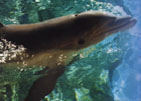 |  |  |
|
Family: |
HISTORY Commerson's dolphins were first described in 1767 by Philibert Commerson. As a result, this species now bears his name. He had originally sighted these dolphins in the Straight of Megellan, in South America. The Kerguelen Island population in the Indian Ocean was not known of until the 1950s. Commerson's dolphins were originally classified in 1804 under the genus species Delphinus commersonii. Their taxonomic listing was revised in 1846 to their current classification Cephalorhynchus commersonii. LOCATION These dolphins can be found in shallow waters along the southernmost tip of South America and around the Kerguelen Islands in the Indian Ocean. Those found around the Kerguelen Islands are larger than the South American variety, and may be a subspecies. They can often be found in naturally protected waters or harbors, sometimes entering the mouths of rivers. These dolphins prefer more coastal waters, and are most commonly found in the Straits of Magellan, the Falkland Islands, and around Tierra del Fuego, often around kelp beds. APPEARANCE While they may look like porpoises with their stocky body shape and their small, indistinct rostrum, the Commerson's dolphin is unmistakably part of the dolphin family with its bold, outgoing behavior. Because of its striking black and white patterns, this dolphin is also called by other names such as the Skunk dolphin and the Piebald dolphin. Typical coloration of an adult would be a black colored head, with a large black area sweeping back from the dorsal fin to the flukes. It has a white patch on its throat that travels beneath its pectoral fins, then sweeps upwards, covering the whole midsection of the dolphin in white, with a small black patch on the underside that may come up slightly to the sides of the dolphin. At birth, these dolphins don't have the flashy black and white pattern, but are grey, black, and brown. As it grows older, it will become black and grey, with the grey patches developing into the white coloration that the adults possess.
Unlike most dolphins, the dorsal fin of the Commerson's dolphin is wide and rounded. It may curve back slightly, though some individuals have a less rounded find that is almost triangular in shape. Their pectoral fins are rounded as well, and are a solid black on both the top and the undersides. They have anywhere from 108-138 teeth. DIET & BEHAVIOR These dolphins have a wide range of foods as part of their diet. They will consume various sea life such as fish, squid or octopus, crustaceans such as shrimp, and some other invertebrates as well, most likely foraging near the sea floor for their meals. Being dolphins, they are quite active and can swim very quickly, usually around the surface of the water. Commerson's are active breachers, and may breach repeatedly in a short period of time. They may even surf, riding breakers close to shore or heavy swells out at sea. Bowriding is a common behavior, and they may also swim behind vessels, playing in the wake. Underwater, a Commerson's dolphin may engage in swimming upsidedown or spinning while swimming. REPRODUCTION & LONGEVITY Gestation is about 11-12 months with this species. At birth, Commerson's dolphin calves are fairly large - almost half the size of their mothers. They can measure anywhere between 22 to 30 inches in length (56 - 76 cm). These dolphins can live into their late teens. THREATS In both Chile and Argentina, these dolphins are sometimes hunted. Though illegal, their meat is occasionally used for crab bait. Entanglement in fishing nets also poses a threat. LINKS
| |


 Sex can be distinguished in these dolphins based on their markings. In males, the black marking around the genital area will be shaped like a teardrop. The black marking on females is shaped more like a rounded arrowhead. Females of this species are also generally larger than males.
Sex can be distinguished in these dolphins based on their markings. In males, the black marking around the genital area will be shaped like a teardrop. The black marking on females is shaped more like a rounded arrowhead. Females of this species are also generally larger than males.